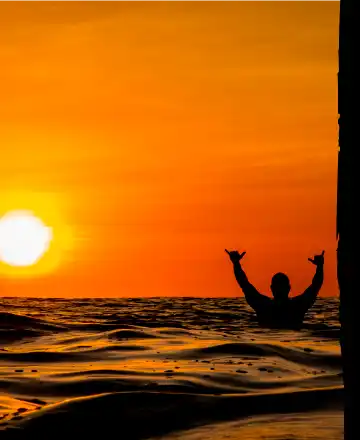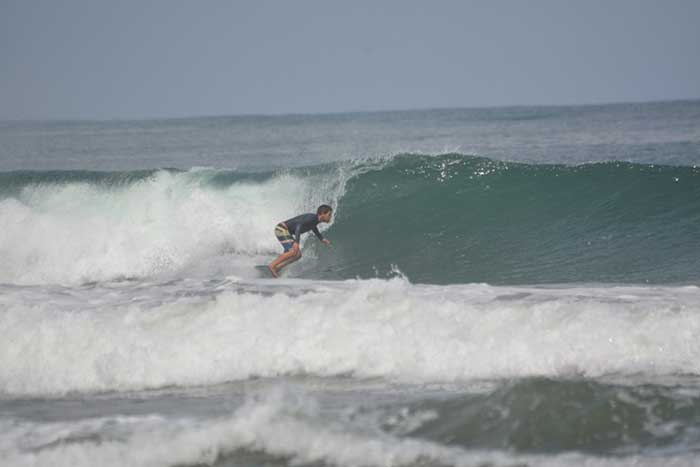
Casitas - Playa Grande
Wave Quality: Average ( 6.5/ 10)
Ideal Swell Direction: SW (215 – 230) NW (280 – 300)
Ideal Wave Height: waist high – head high
Best Wind Direction: ENE
Best Tide: Mid-high
Required Experience: Beginner – Advanced.
Best Board: Longboard, Funboard, Fish
Bottom: Sandy
Crowd: Moderate
Wave Power: (4.5 / 10)
Best time of the year: July & August
Casitas - Playa Grande
Location – Casitas is located in Playa Grande within the Las Baulas National Park, approximately 500 meters south of the Palm Beach surf break and 300 meters north of the Tamarindo Rivermouth surf break.
There used to be a small shack (casita) on the beach marking the peak, but it has recently been washed away with a heavy rainy season. You should be able to see an uncompleted hotel within the mangroves that only has the grey-work complete. From the water, line yourself up with this landmark.
Wave Quality -Average – Good (6.5 / 10)
Casitas, located along Playa Grande’s southern coastline, receives just a touch more swell size than Tamarindo on southerly swells. Since most of the swells come from a southern direction, some of the energy is shadowed by Isla Capitan, a small island right offshore of Tamarindo.
There is a rockpile about 100 meters outside of the takeoff zone which will create a uniform left and right A-frame peak. There is also a sweeping right hander about 100 meters to the north of the A-frame.
Ideal Swell Direction – SW (215 – 230) NW (280 – 300)
Since Casitas has a due west orientation, there needs to be a fair amount of west in the corresponding swell. A strong storm that flares up right next to New Zealand or in the central South Pacific will send a healthy dose of SW swell. During the dry season, a giant North Pacific storm will send a noticeable pulse of NW energy that trickles into Casitas.
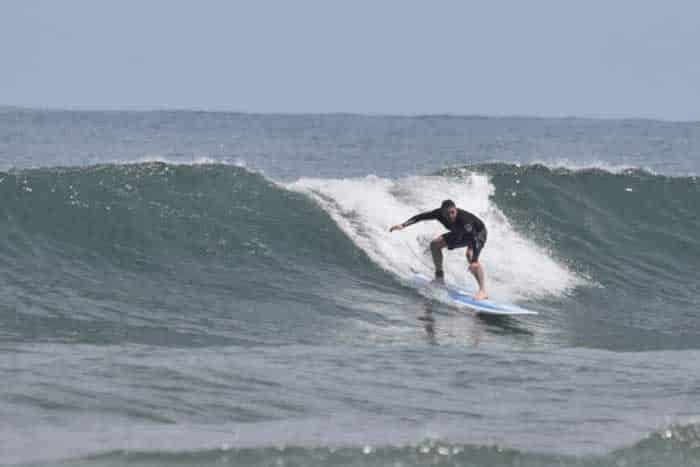
Ideal Wave Height – Waist high – head high
Casitas really loves a medium – large swell. While other breaks may be well overhead, Casitas will remain fun in the chest – head high range with open lines. Since most of the southerly energy is blocked by the offshore island, there needs to be a better-than-average swell on hand if you want to ride anything other than a longboard or funboard.
When there is a very large swell, Casitas can be mixed up with closeouts and currents as the waves will not refract off the outside boil rock correctly.
Best Wind Direction – ENE
Best wind is light – moderate offshore which can range from NNE to NE to ENE. Playa Grande actually has a huge advantage over many other spots to the south because the wind will stay offshore longer. Since Playa Grande is located closer to Lake Nicaragua, the wind will stay offshore here all day while many spots to the south turn onshore around 10am. During the dry season (Dec – April) the offshore winds can be quite strong but the waves generally remain groomed.
Rubber? – Yes (December – April)
Bring some rubber especially if the winds have been blowing offshore for several days. Although rare, water temps can drop down to the low 60sF. This is a phenomenon called upwelling. Normally, water temps hover in the 75 – 80F range. Upwelling really only happens a few times during the dry season. Also, a wetsuit top generally comes in handy for dawn patrol sessions.
Best Time To Score – July – August
July and August are the best months to score Casitas because there is tons of SW swell in the water and predominantly offshore winds. Plus, there are not our high season months so the crowd should be thinner.
Best Tide – Mid – high
Casitas will start working about 2.5 hours after dead low tide and will break all the way up through dead high tide. The wave will change shapes depending on the tide. With a medium tide, there is the possibility for little tube sections and fast walls. With the higher tide, expect a crumbly wave best suited for a longboard or fish. There is not much backwash to contend with at Casitas as the sand berm on the beach is not too vertical.
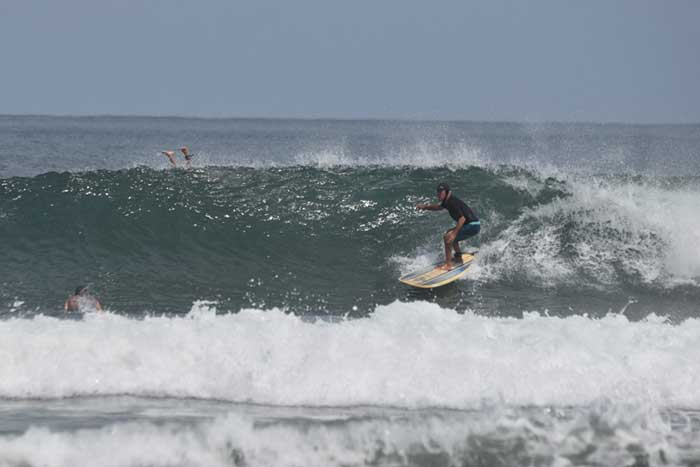
Required Experience – Beginner – Advanced
Casitas is an excellent spot for all levels. The waves are mellow enough so that beginners can surf with little consequence, but the wave has good enough shape that even advanced surfers will find powerful sections and smackable lips.
Best Board – Longboard, funboard, fish
Casitas is a great wave for novelty sessions on a longboard or an alternative board. Unless there is a large swell on hand, a high-performance shortboard is generally not the best choice.
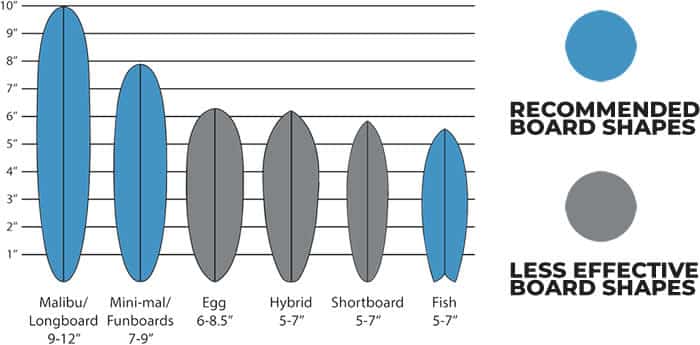
What’s On The Bottom? Sandy bottom
What’s The Crowd Like? – Moderate
Since Casitas is visible from the beach in Tamarindo and offers more reliable shape, many Tamarindo surfers will make the short walk and boat ride across the estuary for a quick session. The waves are suited for all levels so expect to dodge some torpedo longboards along with a few experience surfers flying down the line.
How Powerful Is The Wave? (4.5 / 10)
Although Casitas has a desirable A-frame shape and long lines, the wave can feel a bit gutless on the takeoff and down the line. Granted, there are some powerful sections when the swell gets bigger, but the wave itself is slopey and best for mellow cruising. Best for cutbacks, floaters and off-the-tops.
Perfecto Meter – (7 / 10) (1 = Lake Michigan wind chop / 10= Kelly Slater Surf Ranch)
On an ideal day with the perfect swell angle, size, and light offshore winds, you will find lots of open waves breaking at just the perfect speed for cruising and mellow maneuvers. Although the wave lacks a big barrel and ample power, the shape of the wave and length of rides contribute to the higher-than-average perfecto meter rating.
Spaghetti Arm Index – (5/10)
It’s possible to get caught inside on a set (especially with a longboard), but the wave itself doesn’t break all that far from the beach, especially with the higher tides. The Spaghetti Arm Rating of 5 is for the surfers that paddle over from Tamarindo. Do not paddle across the estuary. Paddle out and around the rock outcropping north of the Estuary. It is a fairly long paddle, but generally worth it.
Hazards – Beginners, flying boards, crocodiles
How Do I Get There?
From the Tamarindo beach break, you can get to Casitas in about 10 minutes. This requires crossing the estuary (hire a boat taxi) and then a short 5 minute walk. The main peak is located just past the rock outcropping on the north edge of the Tamarindo Rivermouth.
Download the Trip Guide
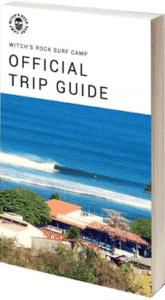
- See why guests return year after year
- Review all of our surf packages
- Learn what a typical week at surf camp looks like
- How to get here, what to pack, when to travel, and more…

